How many calories do you need a day?
How many do you really burn?
Do you know? For sure?
Are those generic calculators on line, the ones with weight, height, age input, accurate? How can they be for everyone? Doesn’t activity level count? Muscle mass?
I am 5’3.6” and weigh 115 pounds. The on-line calculators say:

And yet when I ate 1422 calories, I was so weak I thought perhaps my cancer returned! And weight training days 1778 didn't sustain me either. Hmmmm.
I tracked my calories at fitday.com for several years (before cancer). It is free and easy to use. You put in everything you eat during the day, it totals it, shows nutrition deficits, weight changes over time, etc. Nice program. I used it all during chemo.
Into fitness pretty much all my adult life, the above are just a few questions I started asking after chemotherapy damaged my heart. If the heart isn’t beating the way it should; muscles aren’t getting the amount of oxygen required to burn maximum calories. Do I eat less? How much less? Work out longer? Do the on-line calculators still apply?
It may not seem like a big deal. But, 3500 calories = 1 pound. So even if the calculations are off by 200 calories a day, a person could pack on 2 pounds a month or more.
So I started looking at everything from pedometers, to heart rate monitors, to calorie burn monitors…all to determine my specific caloric needs.
It came down to Body Bug and Body Media. I settled on Body Media after looking at the software. I bought the blue tooth version on-line for $159 and wear it 24/7. The on-line program is free the 1st 3 months, and $6 a month after. Here is what it looks like.
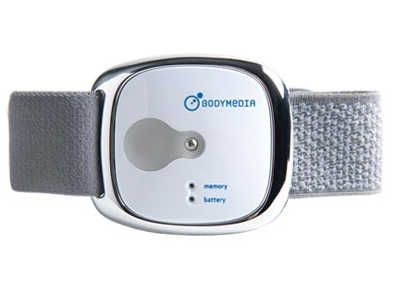
Worn on the left arm 24/7, according to the web site this is how it works (this is boring and if you don't care skip to the software review):
- The armband contains an "accelerometer", a device that we use to measure
many aspects of motion. Your car air-bag system uses an accelerometer to know when you have been in an accident and deploy the air-bag, your Nintendo Wii game controller contains an accelerometer to measure how you move the controller to play the games.
- We count your steps, using the distinctive walking and running motions measured by the accelerometer.
- We measure your "Galvanic Skin Response". The two stainless steel pads
on the back of your armband are the GSR sensor that determine how much you are sweating.
- We measure your skin temperature using an electronic thermometer inside the armband.
- We measure the rate at which heat is being dissipated from your body, this is your "heat flux". Exercise physiologists are interested in the heat energy
produced by the body, your muscles are fairly inefficient and we all produce a lot of heat energy when we perform physical work.
A quick review of the software.
Hooked up to your computer to download your specific data, you go to the website, log in and the picture below shows what the arm band monitors/measures. Clicking on the down arrow elaborates on that specific activity (subsequent pictures). (If purchasing the blue tooth, this is also available on your smart phone!)
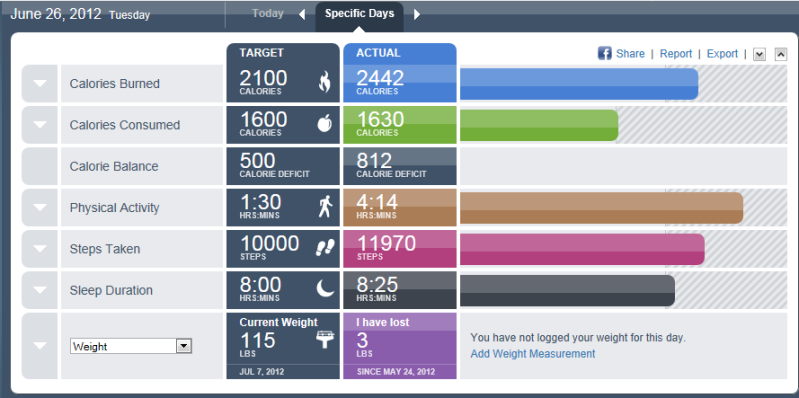
"Calories burned" Charts the intensity of calories burned below...and time of day.
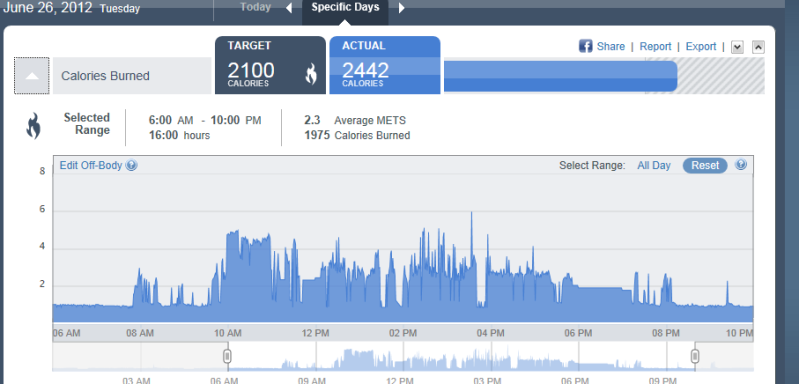
Calories consumed below. You have to input the data, but it is fairly easy to do because there is a large food selection. I like the specificity.
In the off chance your food/restaurant isn't listed, you can create your own food that will stay forever in your library.
For example. Hummus.
Cheesecake Factory Hummus is nutritionally different than homemade, or store bought. While the latter two are in the Body Media library.....I had to look up Cheesecake Factory Hummus on Google and enter it manually into the library. But now it is in my library under "my foods" any time I want it.
Here is a shot of the daily calorie intake, as well as nutritional breakdown. The nutritional breakdown is helpful as it helped me pick an appropriate multi vitamin to fill in the gaps. (For example, I don't eat a lot of breads...so my thiamine levels are almost non-existent. I supplement those.)
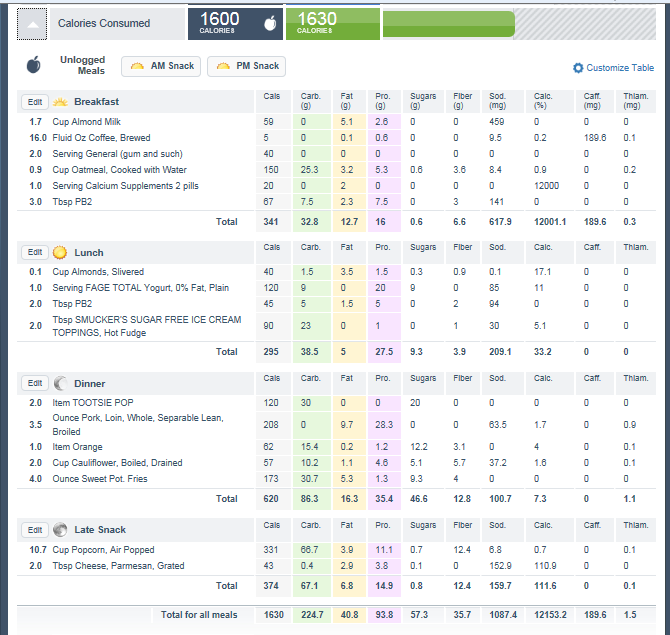
Don't judge my nutrition by this day. I usually eat lots more veggies. I picked this day at random. lol

Here is where meals/snacks are entered. Can do this from your smart phone if Body Media Blue Tooth is purchased. That's handy when eating out.
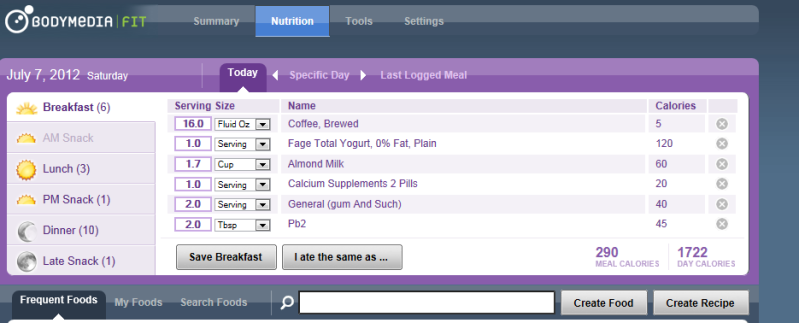
It also monitors your physical activity, and steps taken.
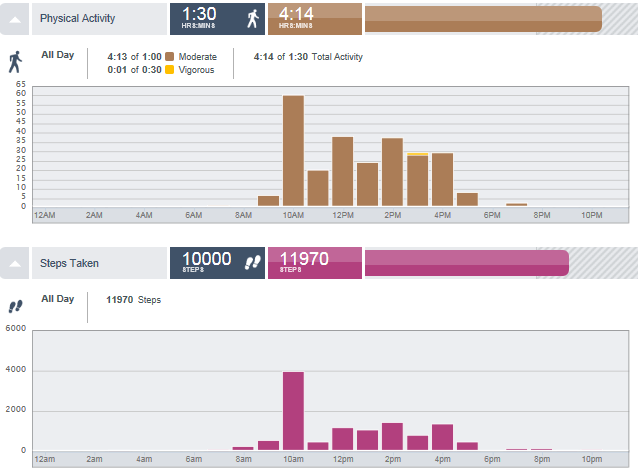
If you've read this far...I have to say my FAVORITE thing about this little device is the next block of information.
SLEEP EFFICIENCY!

Black is sleeping, gray is coming up out of REM sleep/laying down. How awesome is that? What I discovered is when I sleep alone (husband out of town) my sleep eff. is about 95-96%. When he is home it varies between 80-90%.
Why is that important? I won't go into all the details here (you can google it), but generally speaking weight loss, healing, productivity are all hampered by poor sleep.
The arm band is charged by computer and lasts about 3 days. Once charged, every time you plug it into the computer it re-charges pretty fast, within minutes.
Drawbacks/Negatives
1. Monitoring exercise...it is meant for medium to high impact exercises. Low impact exercises like a cross trainer aren't given correct calorie burn numbers.
For instance, I use my cross trainer for 60 minutes at the highest intensity. Sweat pours off me, I can't sing, I can't talk, and almost every single muscle group is engaged. On a scale of 1-10 my exertion level stays about 8 and pops up to 9-10 for the entire hour+.
For some reason the body media band says I burn something like 200 calories and my exertion level never gets above moderate. If you look above at "physical activity" or "calorie burn" windows, you can't really tell I used my cross trainer for 60+ minutes starting at about 10am.
How do I know it doesn't "read" low impact exercise (yoga, pilates, weight lifting ,etc) correctly? Because on the days I also walk a 5 mile loop and don't break a sweat, don't breath hard, the monitor shows me burning 400+ calories, and having a higher exertion than the Cross Trainer.
So obviously impact has something to do with the way it works. Also when I jog in place it registers high and I'm not working half as hard as when I do the cross trainer.
But I didn't get it for exercise readings. In fact, a heart rate monitor would be a better tool to gauge exertion level for that specific period of time.
2. Not water proof (sweat is fine)
3. While you can enter calories consumed on your smartphone, and see the first general menu (sleep, steps, calories burned, etc) you can't see the expanded data on each of those.
4. Be prepared for comments and questions. Most people are really good about it, but some are well, stupid. What can I say. They just are.
WHAT I LEARNED
1. Most days I burn 24-2500 calories. The reason I felt so weak wasn't because cancer returned. I wasn't eating enough to fuel my workouts.
2. I burn over 500 calories sleeping....lol
3. I can tell without even checking now how I slept by the intensity of my workout the next day.
4. Sugarless chewing gum has between 5-10 calores a stick. Several vitamin supplements also have calories. All that has to be factored in. Even coffee has a few calories. All of this adds up for me to about 100 calories a day! That's almost a pound a month if I don't count it.
5. I burn 2400 but can't consume that much to maintain my weight. For whatever reason (maybe my heart?) if I don't have at least a 500 calorie deficit every single day, I start to retain water first, and then gain weight.
6. I didn't really weigh 118 at starting in May...I just went with my highest weight the last 6 months when I started. For fun 
Recommendations
All in all, this is vital information if you are trying to lose weight. As we age, we lose muscle mass (unless regular resistance exercise/weight lifting) and don't need as many calories.
This allows a person to see how many calories they're burning, and adjust consumption easily. If a deficit is created, weight is lost. Technically this can be done without exercise, though we all know exercise is important. 